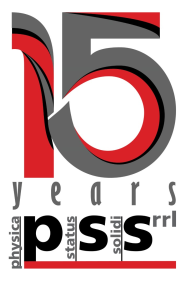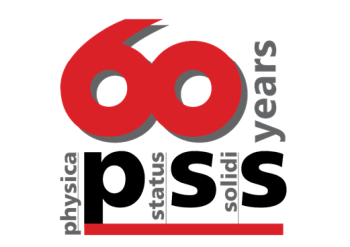Overview
Aims and Scope
The physica status solidi (pss) journal group is devoted to the thorough peer review and the rapid publication of new and important results in all fields of solid state and materials physics, from basic science to applications and devices. Among the largest and most established international publications, the pss journals publish reviews, letters and original articles, as regular content as well as in special issues and topical sections.
physica status solidi (a) – applications and materials science covers modern solid-state physics and physical materials science with an emphasis on materials and device applications. This encompasses the preparation, analysis and description of solid, advanced material systems, nanostructures, films, surfaces and interfaces with respect to electronic, magnetic, optical, thermal, structural and morphological properties, as well as device design and characteristics. Current topics include semiconductor electronics and optoelectronics, organic electronics, photovoltaics, sensors, thermoelectrics, non-volatile memory, resistive switching, spintronics, dielectrics, ferroics and superconductors.
physica status solidi (a) – applications and materials science is a sister journal of the pss flagship physica status solidi (RRL) – Rapid Research Letters, which employs priority editorial handling to offer cutting-edge research publication at record speed, and of physica status solidi (b) – basic solid state physics.
physica status solidi (a) is a subscription-based journal offering a hybrid open access option. Authors may publish with Wiley-VCH copyright transfer agreement at no direct cost to the author, or select a CC-BY open access license after acceptance. Wiley has many agreements in place with institutions and funders that may be able to help with Article Publication Charges.
ISSN: 1862-6300 (print). 1862-6319 (online). CODEN: PSSABA.
Currently 24 issues per year.
How to cite: To make sure that references to this journal are correctly recorded and resolved (for example in CrossRef, PubMed, or Web of Science), please use the following abbreviated title in any citations: "Phys. Status Solidi A" (punctuation may vary according to the style of the citing journal).
Readership
physicists, materials scientists, crystallographers, chemists, and device engineers dealing with solid-state physics or materials science in basic or applied research and teaching
Keywords
solid-state physics, device physics, applied physics, junctions, thin films, quantum dots, nanotubes, nanostructures, defects, morphology, structure, band structure, doping, charge transport, lattice, dynamic, electronic, thermodynamic, electromechanic, optical, dielectric, ferroelectric, and magnetic properties, epitaxy, growth, patterning, imaging, diffraction and spectroscopy, semiconductors, oxides, kesterites, graphene, diamond, superconductors, topological insulators, multiferroics, phase change materials, perovskites, transparent conducting oxides, high-k dielectrics, organic electronics, photovoltaics, optoelectronics, flexible electronics, magnetoresistance, spintronics, memories, resistive switching, sensors, nanotechnology
Abstracting and Indexing Information
- Advanced Technologies & Aerospace Database (ProQuest)
- CAS: Chemical Abstracts Service (ACS)
- Chemical Abstracts Service/SciFinder (ACS)
- COMPENDEX (Elsevier)
- CrossFire Beilstein (Elsevier)
- Current Contents: Physical, Chemical & Earth Sciences (Clarivate Analytics)
- ENERGY (FIZ Karlsruhe)
- ICSD: Inorganic Crystal Structure Database (FIZ Karlsruhe)
- INIS: International Nuclear Information System Database (IAEA)
- INSPEC (IET)
- Journal Citation Reports/Science Edition (Clarivate Analytics)
- Materials Science & Engineering Database (ProQuest)
- Physics Abstracts (IET)
- Science Citation Index (Clarivate Analytics)
- Science Citation Index Expanded (Clarivate Analytics)
- SciTech Premium Collection (ProQuest)
- SCOPUS (Elsevier)
- Technology Collection (ProQuest)
- VINITI (All-Russian Institute of Science & Technological Information)
- Web of Science (Clarivate Analytics)






